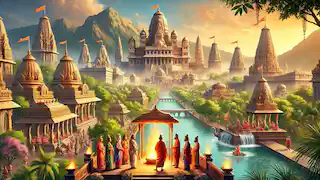Chapter 1: The Birth of Rama
In the ancient city of Ayodhya, ruled by the wise and just King Dasharatha, there was a deep longing for an heir. Despite his three wives, Queen Kausalya, Queen Kaikeyi, and Queen Sumitra, the king remained childless. Desperate for a solution, King Dasharatha performed a grand yajna, a sacred fire ritual, seeking the blessings of the gods for progeny.
The gods were pleased with Dasharatha's devotion and sent forth a divine messenger with a golden vessel filled with a special potion. The messenger instructed the king to distribute the potion among his queens. Obediently, Dasharatha gave the potion to his queens, who soon after, bore him four sons. Queen Kausalya gave birth to Rama, Queen Kaikeyi to Bharata, and Queen Sumitra to the twins, Lakshmana and Shatrughna.
Rama, the eldest, was a reincarnation of Lord Vishnu, sent to earth to rid the world of evil. From a young age, he exhibited qualities of compassion, wisdom, and unparalleled prowess in archery. His brothers, too, showed remarkable talents and virtues, forming a close-knit, loving family. The kingdom of Ayodhya flourished under the guidance of King Dasharatha and the promising future of his sons.
Rama's childhood was filled with lessons in dharma (righteousness), archery, and statecraft. His guru, Sage Vashistha, taught him the Vedas and the importance of living a virtuous life. Rama, with his brothers by his side, excelled in his studies and became proficient in the use of divine weapons.

Chapter 2: The Swayamvara of Sita
As the princes grew, their fame spread far and wide. One day, Sage Vishwamitra arrived in Ayodhya, requesting Rama's assistance to protect his yajna from demonic disruptions. With Dasharatha's reluctant consent, Rama and Lakshmana accompanied the sage, successfully defending the ritual from the rakshasas (demons) Maricha and Subahu. This journey marked the beginning of Rama's encounters with the forces of evil.
Their journey led them to the kingdom of Mithila, ruled by King Janaka. Janaka had a daughter, Sita, renowned for her beauty and virtue. The king had vowed to marry her to the one who could string the mighty bow of Lord Shiva, an impossible task for many suitors.
During the swayamvara, numerous princes and warriors attempted but failed to string the bow. When Rama's turn came, he lifted the bow effortlessly, not only stringing it but breaking it in the process. This incredible feat won Sita's hand in marriage, and the couple's union was celebrated with great joy and grandeur. The marriage of Rama and Sita symbolized the union of two noble souls destined to overcome great trials together.
The journey back to Ayodhya was filled with festivities and joyous celebrations. Upon their return, Rama and Sita received blessings from the elders and the people of Ayodhya. Their love for each other grew stronger, and they became the epitome of an ideal couple, admired by all.
Chapter 3: The Exile
As time passed, King Dasharatha grew old and decided to anoint Rama as his successor. The kingdom rejoiced at the news, for Rama was beloved by all. However, Queen Kaikeyi's maid, Manthara, poisoned Kaikeyi's mind with jealousy and fear, convincing her to demand two boons previously granted by Dasharatha.
Kaikeyi, swayed by Manthara's manipulations, asked for Bharata to be made king and for Rama to be exiled to the forest for fourteen years. Bound by his promises, Dasharatha reluctantly agreed, heartbroken and helpless.
Rama, ever dutiful and righteous, accepted his fate without protest. Sita and Lakshmana, out of love and loyalty, insisted on accompanying him. Thus, the trio donned simple garments and left the comforts of the palace for a life of austerity in the forest, leaving behind a grieving Ayodhya.
Bharata, who was away during this incident, returned to find his father dead and his beloved brother exiled. Devastated and angry, Bharata confronted his mother and rejected the throne. He set out to find Rama and bring him back, but Rama, bound by his duty, refused to return before the completion of the exile. Instead, Bharata took Rama's sandals and placed them on the throne, ruling Ayodhya as a regent in Rama's name.
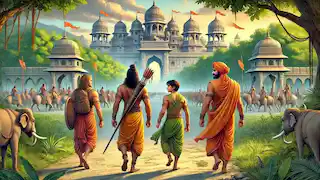
Chapter 4: Life in the Forest
Rama, Sita, and Lakshmana roamed various forests, living a life of simplicity and penance. They built humble abodes, subsisted on fruits and roots, and spent their days in peaceful contemplation. Their journey brought them to the forest of Panchavati, where they constructed a beautiful hermitage.
Their peaceful existence was disrupted by the demoness Surpanakha, sister of the powerful demon king Ravana. Enamored by Rama's beauty, Surpanakha attempted to seduce him, but Rama gently rebuffed her. Angered, she attacked Sita, prompting Lakshmana to intervene and mutilate her, sending her fleeing in rage and humiliation.
Surpanakha sought revenge by inciting her brothers Khara and Dushana to attack Rama, but they were swiftly defeated. In her desperation, she turned to Ravana, describing Sita's unmatched beauty and urging him to abduct her.
During their exile, Rama, Sita, and Lakshmana encountered many sages and hermits, gaining their blessings and wisdom. One such sage was Agastya, who gifted Rama divine weapons that would later prove crucial in his battles. The trio also vanquished numerous demons, purifying the forests and bringing peace to the regions they traversed.
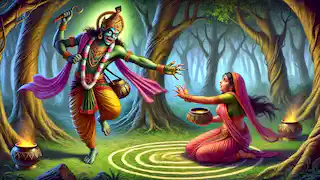
Chapter 5: The Abduction of Sita
Ravana, captivated by Surpanakha's description of Sita, devised a plan to abduct her. He enlisted the help of Maricha, a demon capable of shape-shifting, who transformed into a golden deer to lure Rama and Lakshmana away from the hermitage.
Sita, enchanted by the deer's beauty, begged Rama to capture it for her. Despite his reservations, Rama agreed and set off, instructing Lakshmana to stay and protect Sita. As Rama pursued the deer, he realized it was a trap and killed it. With his dying breath, Maricha mimicked Rama's voice, crying out for help.
Hearing the cry, Sita implored Lakshmana to find Rama. Reluctantly, Lakshmana drew a protective circle around the hermitage, instructing Sita not to step outside it, and left to search for his brother. Ravana seized this opportunity, disguised as a mendicant, and approached Sita. Deceived by his guise, Sita stepped out of the protective circle to offer alms, and Ravana swiftly abducted her, taking her to his kingdom of Lanka.
Ravana's journey back to Lanka was fraught with obstacles, as he encountered Jatayu, the noble vulture who valiantly fought to save Sita. Despite his courage, Jatayu was mortally wounded by Ravana. With his last breath, Jatayu revealed the direction in which Ravana had taken Sita.
Chapter 6: The Search for Sita
Rama and Lakshmana, upon discovering Sita's absence, were devastated. They began a relentless search, traversing dense forests and rugged terrains, encountering various sages, and vanquishing numerous demons along the way. Their journey led them to the dying Jatayu, a noble vulture who had fought bravely to save Sita but was mortally wounded by Ravana.
With his last breath, Jatayu revealed the direction in which Ravana had taken Sita. Rama and Lakshmana continued their quest, eventually meeting Hanuman, the devoted servant of Sugriva, the exiled monkey king. Sugriva, upon hearing their plight, pledged his support in the search for Sita.
Hanuman, with his extraordinary abilities, leaped across the ocean to Lanka, where he found Sita imprisoned in a grove, guarded by fearsome demons. Hanuman reassured Sita of Rama's impending rescue, gave her a token from Rama, and returned to convey the news.
Upon Hanuman's return, Sugriva mobilized the entire monkey army to assist Rama. The army, consisting of countless brave warriors, prepared for the arduous journey to Lanka. They faced numerous challenges, including building a massive bridge across the ocean, a feat accomplished through the combined efforts of the monkey soldiers and the blessings of Lord Rama.
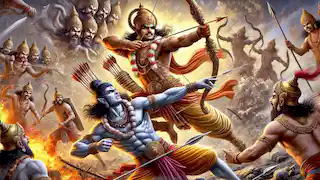
Chapter 7: The Battle of Lanka
With the help of Sugriva's vast monkey army, Rama and Lakshmana built a bridge across the ocean to Lanka. Upon reaching Ravana's stronghold, a fierce battle ensued. The air was filled with the clash of weapons and the cries of warriors, as both sides fought valiantly.
Rama faced many formidable foes, including Ravana's powerful son Indrajit and his brother Kumbhakarna. Despite their immense strength and cunning, Rama and his allies triumphed through their unwavering courage and righteousness.
The final confrontation between Rama and Ravana was a spectacle of epic proportions. After a long and grueling battle, Rama, with the aid of his divine weapons and unwavering focus, struck Ravana down, freeing Sita from her captivity.
Throughout the battle, the bravery and loyalty of Rama's allies shone brightly. Hanuman's feats, including setting Lanka ablaze and bringing the healing herbs to revive Lak
shmana, became legendary. Vibhishana, Ravana's brother who had defected to Rama's side, played a crucial role in providing intelligence and guidance.
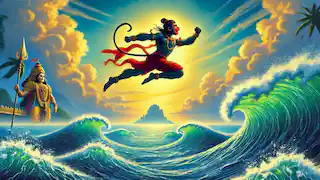
Chapter 8: The Return to Ayodhya
The defeat of Ravana marked the end of Sita's ordeal and the beginning of their journey back to Ayodhya. Rama, Sita, and Lakshmana, accompanied by their loyal allies, were greeted with immense joy and celebration upon their return.
The fourteen years of exile had come to an end, and Rama was rightfully crowned king. His reign, known as Ram Rajya, was marked by justice, prosperity, and happiness, embodying the ideals of a perfect ruler. Rama, Sita, and Lakshmana, along with their devoted companions, continued to uphold the values of dharma, inspiring generations to come.
During his reign, Rama implemented numerous reforms that ensured the welfare of his people. He prioritized justice and fairness, making Ayodhya a haven of peace and prosperity. Sita, as queen, became a symbol of grace and virtue, supporting Rama in all his endeavors.
The stories of their trials and triumphs were passed down through generations, becoming an integral part of Indian culture and spirituality. The Ramayana, with its timeless lessons of duty, love, and righteousness, continued to inspire countless individuals in their quest for a virtuous life.
